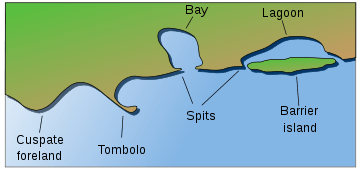Intertidal wetland
An intertidal wetland is an area along a shoreline that is exposed to air at low tide and submerged at high tide. This type of wetland is defined by an intertidal zone and includes its own intertidal ecosystems.
Description
The main types of intertidal wetlands are mudflats (e.g., mangrove swamps) and salt marshes. The mangrove swamps are encountered along tropical shores and are characterized by tree vegetation, while salt marshes are mostly found in temperate zones and are mostly grass ecosystems.[1]
Intertidal wetlands are commonly encountered in most estuaries. Intertidal wetland ecosystems are amongst the most productive plant communities and often constitute a large part of the estuary areas.[1]
See also
References
- 1 2 Estuarine Ecology, by John W. Day, Alejandro Yáñez-Arancibia , Chapter 5: Intertidal Wetlands: Salt Marshes and Mangrove Swamps
This article is issued from Wikipedia - version of the 10/25/2016. The text is available under the Creative Commons Attribution/Share Alike but additional terms may apply for the media files.



